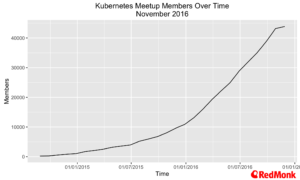The growth around the Kubernetes ecosystem over the last year has been extremely strong, with a number of vendors building commercial offerings based on Kubernetes. The project itself continues to grow at pace, and its popularity shows no signs of abating.
The Kubernetes Community
We have looked at the overall code contributions to Kubernetes a number of times before, and the major trends that we have previously observed still hold. With the level of interest in the project continuing to increase and with Kubecon occurring in Seattle this week, an update felt timely.
The top ten companies still continue to dominate the overall contributions for the project having now contributed over 86% of all code to Kubernetes since the start of the project. That said, this is a slight decrease from our last analysis back in March.
Google continue to be, by far, the biggest contributor. Looking at the top ten contributions beyond Google we see the next two tiers of contributions.
The overall velocity of commits has calmed down from the frantic pace we saw late last year, reflecting a fast maturing project and codebase. That is not to say that the velocity has slowed when compared to other projects – the rate of change for Kubernetes has made it one of the most active projects on github.
On the issues front the diversity continues to grow, with just under 72% of all issues coming from the top ten companies, another decrease since March. The diversity in companies logging issues, given the volume of change within the project, is reflective of a growing adoption.
Meetup Growth
The growth in interest in Kubernetes meetups has been quite astounding, but it should be taken with some caveats. From a base of just over 15,000 back in March we now see almost 45,000 people attending meetups that have indicated an interest in Kubernetes, almost a 3x increase.
As mentioned there are some caveats to be aware of here, included in this data is meetups such as Advanced Spark and Tensorflow in the Bay Area and Time Series Databases in London. Kubernetes may be of interest to these communities, but it is interest, at best, in a tangential sense.
Even with such caveats, there is still a massive growth in interest. No matter what way you look at the data any project showing an almost 200% increase in meetups in under eight months is demonstrating a groundswell of support from various communities.
The Next Steps
There is still a long way to go in terms of wider adoption for Kubernetes, and Cloud Native approaches in general. While the growth of Kubernetes is very impressive, the community would do well to remember that the end goal is for developers to create applications.
Containers are great, but lets be honest, they only solve part of the problem while creating new ones. Focus on the application.
— Kelsey Hightower (@kelseyhightower) November 6, 2016
As Kubernetes becomes a stable platform, the next set of questions, particularly for vendors in the community is how to move from interest to teaching the wider developer world how- to develop end user applications on Kubernetes. When one steps back and looks at all of these communities
Notes on this analysis
We remove automated contributions (e.g. web-flow and k8s-merge-robot) from our calculations. Brendan Burns moved to Microsoft recently, and the change in attributions for his contributions since his move is not accurately reflected in these numbers.
Disclaimers: The Linux Foundation, Red Hat, Engine Yard, IBM, Microsoft, CoreOS, Meteor and Huawei are current RedMonk clients.











No Comments